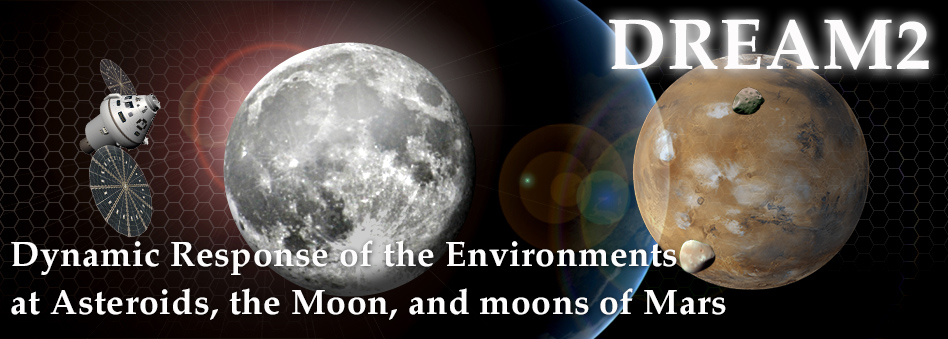
Dynamic Response of the Environments at Asteroids, the Moon, and moons of Mars
Goddard's DREAM2 Center for Space Environments
DREAM2 incorporates over 30 science investigators from over 10 academic Institutions to study the space environment at exploration targets. DREAM2 is:
- A theory, modeling, data analysis research team examining the space environment at airless bodies
- Answering "How does the space environment affect volatiles, exospheres, plasmas, surface micro-structure, and visiting human systems at any exposed rocky body?"
- Emphasizing the dynamic solar storms and human interactions at airless bodies.
- A modeling center that maintains, advances, and integrates state-of-the-art neutral, plasma, radiation, and surface interaction models
- Sponsored by Solar System Exploration Research Institute (SSERVI) Headquartered out of Ames Research Center Moffett Field CA, 94035
DREAM2 NEWS
DREAM2 proton implantation lab work now made into new video
September 18, 2019
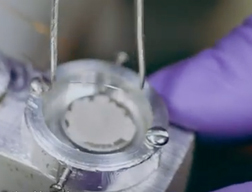
Ongoing lab work on proton implantation and hydroxylation of lunar regolith is featured in a new short video produced by NASA/GSFC. The video is designed to give people insight on what scientists do and the video shows the lab where DREAM2 co-is do some of their beam work. See https://youtu.be/hJMsgRnb1JU and https://svs.gsfc.nasa.gov/13315.
Living and Working on the Moon
July 19, 2019
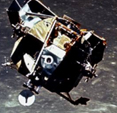
DREAM2 team members Parvathy Prem at Johns Hopkins University/Applied Physics Laboratory and Christine Hartzell at the University of Maryland were recently interviewed as part of a NASA feature addressing the complex, two-way interactions between human systems and the lunar environment. The article is located at:
https://www.nasa.gov/feature/goddard/2019/a-few-things-artemis-will-teach-us-about-living-and-working-on-the-moon
NASA Scientists find Sun's history buried in Moon's crust
June 25, 2019
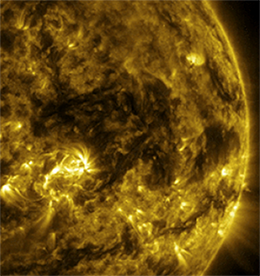
DREAM2's Rosemary Killen was part of a recent study that found evidence for a relatively slow solar rotation rate in the early history of the Sun. The inference is based on the sputtering efficiency of sodium and potassium at the Moon, the correlation of stellar rotation rates and flare activity, and the amount of these lunar volatiles remaining today. If the Sun had been a relatively fast rotator, more flare activity would have been expected leading to a greater lunar surface sputtering loss (erosion) of volatiles sodium and potassium. The NASA press release for this work can be found at
https://www.nasa.gov/goddard/2019/feature/nasa-scientists-find-sun-s-history-buried-in-moon-s-crust/
The research paper can be found at
https://iopscience.iop.org/article/10.3847/2041-8213/ab18fb/meta
DREAM2’s Hartzell examines dust levitation at asteroids
June 10 2019
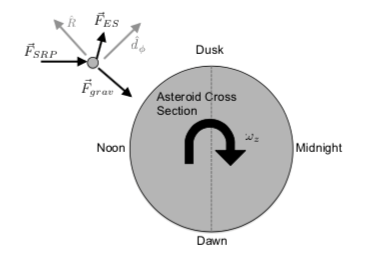
Using a new 2D model, DREAM2 team member Christine Hartzell examined the motion of charged dust grains at a circular asteroid applying electrostatic forces, solar radiation forces, and gravity to determine particulate trajectories. In some cases, the grains were found to escape the vicinity of asteroid due to acceleration by solar radiation. The paper describing the new research can be found at:
https://www.sciencedirect.com/science/article/abs/pii/S0019103518305359
DREAM2’s Killen presents new coronagraphic observation of the lunar sodium exosphere
April 11 2019
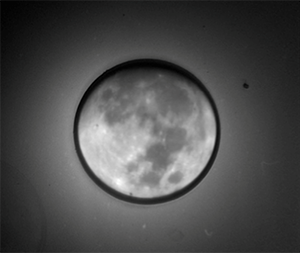
DREAM2’s Deputy PI Rosemary Killen was co-lead of a team that built and deployed a custom-designed robotically controlled coronagraph now housed at the Winer Observatory in Arizona. The system has been used to make lunar sodium exosphere observations in proximity to the lunar surface via occultation techniques provided by the coronagraph. The latest findings from this novel observatory were recently published and the open access article can be found at:
https://doi.org/10.1016/j.icarus.2019.02.027
DREAM2 Annual Report for Program Year 5
March 12 2019
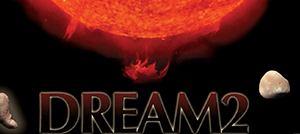
DREAM2 submitted its annual report to SSERVI-Central detailing the center’s major thrusts and accomplishments in the last program year. Examples of the terrific new DREAM2 work include studies on the solar wind’s interactions within the lunar regolith, modeling of the water liberated by meteoric impacts on the lunar surface, the first-ever mapping of the tenuous lunar ionosphere, and new estimates of the permissible mission duration by an explorer in the changing cosmic ray environment. This work was done in coordination and support by a substantial team of early-career scientists and interns. The report can be downloaded at:
https://ssed.gsfc.nasa.gov/dream/docs/2019/DREAM2.annualreport.PY5.031219.pdf
DREAM2 Co-I Poppe explains the enigmatic lunar swirls
March 6 2019
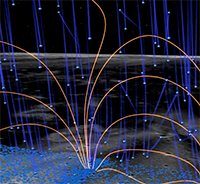
DREAM2 Co-I Andrew Poppe is featured in a NASA web video on the possible solar wind role in the formation of the lunar swirls – the enigmatic bright surface features associated with some lunar magnetic anomalies. The video can be found at:
https://svs.gsfc.nasa.gov/cgi-bin/details.cgi?aid=13150
DREAM2 scientists on NASA's 'Science Live' TV Show
February 28 2019

The premiere episode of NASA's new live TV program, 'Science Live' included DREAM2 scientists discussing the latest lunar science and taking questions live on NASA TV. DREAM2 Co-I Dana Hurley was on the panel describing her work and answering questions. Interspersed video segments featured DREAM2's Andrew Poppe in a new video describing the enigmatic lunar magnetic anomalies and DREAM2's Jacob Bleacher in a video describing the curious lunar lava tubes.
This first episode can be found at https://www.nasa.gov/nasasciencelive
DREAM2 Co-I Tucker leads a study of hydroxyl formation on the lunar surface
February 21 2019
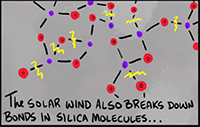
DREAM2 Co-I Orenthal Tucker led a team of modelers examining the process of solar wind proton implantation into the lunar surface, hydrogen diffusion, and subsequent molecular hydrogen outgassing into the exosphere. The same oxygen-hindered hydrogen diffusion rates could explain both the surface concentration of solar wind implanted hydrogen/hydroxyl as observed in the infrared by Chandrayaan-1's Moon Mineralogy Mapper and also the molecular hydrogen exospheric density as observed by LRO’s Lyman Alpha Mapping Project. A web feature can be found at
https://www.nasa.gov/feature/goddard/2019/nasa-scientists-show-how-ingredients-for-water-could-be-made-on-surface-of-moon-a-chemical-factory
and the journal paper can be found at
https://agupubs.onlinelibrary.wiley.com/doi/full/10.1029/2018JE005805
DREAM2 wins Robert H. Goddard Team Award
January 31 2019

The DREAM2 team was awarded the prestigious Robert H Goddard team award for excellence in science. The Citation reads: For excellence in the application of space environmental science to exploration applications. Congratulations to all the DREAM2 team members for their terrific activities.
DREAM2 at the AGU
December 14 2018

Many DREAM2 team members are participating at the annual meeting of the American Geophysical Union (AGU) in Washington, DC. Besides a number of poster and oral presentations, DREAM2 co-I Dana Hurley is co-convener of a session called 'New Perspectives on Dynamic Lunar Processes'.
See:
https://fallmeeting.agu.org/2018/.
New research on dielectric breakdown of lunar regolith
November 08 2018
DREAM2 Co-I Andrew Jordan lead a team of investigators in the examination of electrical charge build-up within lunar regolith associated with solar energetic particle events. These particles charge up the top 1 mm of soil, creating large electrostatic field that could possibly lead to localized breakdown within the soil. They modeled this weathering effect across the lunar surface, with the greatest percentage of altered regolith expected at highest latitudes – where the surface is cold and regolith electrical dissipation is reduced.
See:
https://www.sciencedirect.com/science/article/pii/S0019103518301003?dgcid=author.
Four DREAM2 Studies on the Space Environment at Phobos now published in special issue of ASR
September 24 2018
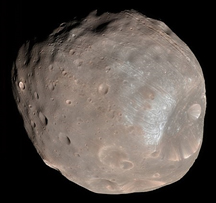
A set of four DREAM2 studies regarding the Phobos space environment were recently published in Advances in Space Research. They are found in the ASR special issue on the 'Past, Present, and Future of Small Body Science and Exploration', Volume 62 (15 October, 2018). The special issue includes DREAM2 articles:
"The possible contribution of dielectric breakdown to space weathering on Phobos" by Jordan et al.
https://www.sciencedirect.com/science/article/pii/S0273117718300759
"Anticipated electrical environment at Phobos: Nominal and solar storm conditions" by Farrell et al.
https://www.sciencedirect.com/science/article/pii/S0273117717305847
"Shaking as a means to detach adhered regolith for manned Phobos exploration" by Hartzell et al.
https://www.sciencedirect.com/science/article/pii/S0273117717306610
"Exospheric escape: A parameter study" by Killen et al.
https://www.sciencedirect.com/science/article/pii/S0273117717304222
DREAM2 Co-I Halekas maps the Lunar Ionosphere
September 19 2018
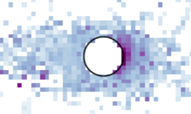
A team led by Jasper Halekas recently mapped out the lunar ionosphere using a set of ARTEMIS measurements from the Electrostatic Analyzer and E-field instruments. The lunar ionosphere became readily apparent during geomagnetic tail crossings since the lunar ionosphere density exceeded that of the low density tail region.
The story has been picked up by National Geographic and can be found at:
https://www.nationalgeographic.com/science/2018/09/news-full-moon-electric-ionosphere-nasa-artemis-space/.
The paper can be found at:
https://agupubs.onlinelibrary.wiley.com/doi/10.1029/2018GL079936.
Solar System Exploration Public Engagement Institute: Update
August 01 2018
Last Thursday, July 26, the DREAM2 team hosted over 40 educators as part of the joint APL/GSFC/LPI SSEPEI program. The educators spent the early part of that week at APL and the National Air and Space Museum, and then a day dedicated to activities here at GSFC. DREAM2 team members and members of the larger GSFC science community provided talks and met with the educators over lunch. Lots of terrific discussions took place. We especially want to thank our own DREAM2 outreach coordinators Nikki Whelley and Andrea Jones for helping to organize the event with APL and LPI.
SSERVI's Exploration Science Forum
July 11 2018

The SSERVI Forum was the last week in June and DREAM2 team members were active participants providing many presentations and posters. Presentations at the meeting, including those from DREAM2 team members, are now online for viewing. See https://nesf2018.arc.nasa.gov/program.
Solar System Exploration Engagement Institute
June 20 2018
DREAM2 is supporting the Solar System Exploration Public Engagement Institute hosted by Johns Hopkins University’s Applied Physics Laboratory. The participants will meet with planetary scientists, hear about the current solar system exploration, and participate in engaging hands-on space science activities. The participants of the institute will visit NASA Goddard Space Flight Center on July 26, 2018, where they will hear talks from DREAM2 scientists, tour Goddard facilities and have lunch with scientists. More information can be found at https://www.lpi.usra.edu/education/solarsystem/
DREAM2 Welcomes New Post-Doc Dov Rhodes
June 14 2018
Dr. Dov Rhodes arrives as a relatively recent Ph. D. graduate in applied physics from Columbia University. While there he worked on computational modeling of MHD plasma instabilities in fusion reactors. On DREAM2, he will be working on astronaut and rover electrical charging in the exposed plasma environments at the Moon and other airless bodies.
Welcome to the team!
DREAM2 team meets for its annual meeting
May 01 2018
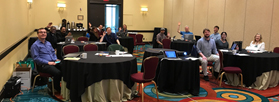
The DREAM2 team met for its annual meeting at the Greenbelt Marriott last week on 4/25 and 26. Team members presented their exciting new research and the team made plans for future science and exploration opportunities. At the team meeting, there was a large representation of the next generation: Post-docs and early career team members who will be part of the next exciting phase of lunar science – very encouraging!
DREAM2 scientist Hurley discusses lunar surface missions
March 13 2018
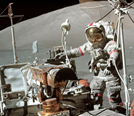
A recent Nature news article discussing NASA’s lunar surface mission approach featured interviews with a number of our outstanding science colleagues, including DREAM2’s Dana Hurley. See
https://www.nature.com/articles/d41586-018-02697-5
DREAM2 submits its Annual Report
February 20 2018
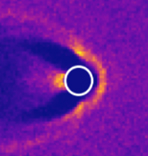
Earlier this month, DREAM2 submitted its annual report to SSERVI-central detailing the terrific activities occurring in the last program year. This last year featured new work such as modeling the plasma environment about 16 Psyche, new models of exosphere gas escape, models of the possible deep dielectric discharge effects as Mars’ moons, and lab work on the hydroxylation of the Moon, just to name a few of topics. The report can be found at:
https://ssed.gsfc.nasa.gov/dream/docs/DREAM2.annualreport.PY4.pdf
The 'Super Blue Blood' Moon Explained
January 31 2018

DREAM2 Co-I Andrew Poppe provides a terrific description of the recent lunar eclipse called the 'super blue blood' Moon. See his timely KRON TV interview that explains this relatively rare event at:
http://kron4.com/2018/01/31/watch-rare-lunar-eclipse-blue-moon-and-supermoon/
Catalyst and Reaction in CHEM
January 25 2018

Multiple SSERVI teams recently submitted to the 'Catalyst' section of the journal CHEM. CHEM's Catalyst approach is to find a new topic and have a discussion about it. The original article defining the issue is called a 'Catalyst' and the added comments to the article are called 'Reactions'. In this case, Thom Orlando (PI REVEALS) wrote the original Catalyst article about REVEALS. Reactions are from DREAM2's Farrell and ESA's Bernard Foing. See:
https://sservi.nasa.gov/articles/catalyst-discussion-and-reaction-to-lunar-science-and-exploration-activities/
Lunar Science for Landed Missions Workshop
January 11 2018
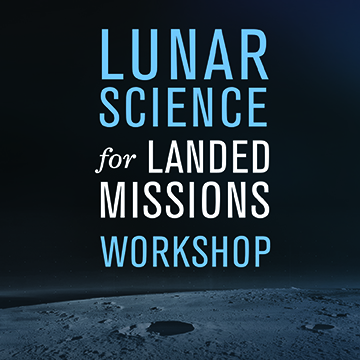
The lunar community, including DREAM2 team members, is meeting at NASA Ames Research Center on 1/10 and 1/11 to discuss science-driven landing targets for the Moon.
For more information, see https://lunar-landing.arc.nasa.gov
To get a flavor for the presentations, the abstracts can be accessed via
https://lunar-landing.arc.nasa.gov/abstracts
The Magneto-plasma Environment at 16 Psyche
December 12 2017
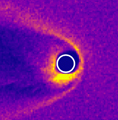
DREAM2 Co-investigators Shahab Fatemi and Andrew Poppe modeled the possible solar wind flow and electromagnetic environment in the vicinity of the metal-rich asteroid 16 Psyche. They include the effects of a possible large-scale magnetic field and high body conductivity on the plasma flow. The work provides preliminary predictions for magnetometer observations during the Psyche Discovery mission. The paper is accepted in GRL and can be found at:
http://onlinelibrary.wiley.com/doi/10.1002/2017GL073980/abstract.
DREAM2’s Rosemary Killen wins Robert H. Goddard Award
October 25 2017
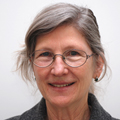
We congratulate our DREAM2 Deputy PI Rosemary Killen who was recently named a Robert H. Goddard Award recipient for her outstanding achievements in science. Rosemary is an internationally recognized leader in the exosphere and surface interaction community, continuing to make significant advances in our understanding of the exospheres at airless bodies, especially both Mercury and the Moon. Congratulations!
Solar eruptions could electrify Phobos
October 23 2017

Powerful solar eruptions could electrically charge areas of the Martian moon Phobos to hundreds of volts, presenting a complex electrical environment that could possibly affect sensitive electronics carried by future robotic explorers, according to a new NASA DREAM2 study. The study also considered electrical charges that could develop as astronauts transit the surface on potential human missions to Phobos.
For more details, see:
https://www.nasa.gov/press-release/goddard/2017/mars-electric-moons
https://www.space.com/38530-solar-wind-charges-mars-moon-phobos.html
The original research article is found at
http://www.sciencedirect.com/science/article/pii/S0273117717305847
DREAM2 Welcomes New Team Members
October 05 2017
The team is thrilled to bring onboard two new post-doc team members
Parvathy Prem joins DREAM2 in an APL Post-Doctorial position in support of DREAM2 exosphere and surface studies. A University of Texas graduate, she has modeled cometary delivery of water and the resulting transient atmosphere at the Moon.
Orenthal Tucker also joins the team in a NASA Post-Doctoral position at GSFC in support of DREAM2 exosphere and surface interaction studies. A University of Virginia graduate, he has a number of works on planetary exospheres, including that at our Moon, Titan, Pluto, and the Enceladus plume.
Welcome to the team!
The 2017 Solar Eclipse
September 01 2017

DREAM2 team members were all over the country observing the eclipse on 21 August 2017! Most of the SSERVI glasses provided to DREAM2 were distributed between the Citadel and the RiverDogs baseball stadium in Charleston, SC where DREAM2 E/PO lead Lora Bleacher assisted in hosting formal NASA events. Team members were located at strategic locations along the path of totality from Oregon to Idaho to the Carolinas. Team members also hosted events, both NASA-sponsored and informally with family and friends. It was a terrific experience shared by millions who gazed in the same direction both Moonward and Sunward that day!
DREAM2 interns present their summer research
August 10 2017
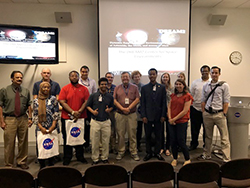
After a summer of work, our DREAM2 interns presented their research results yesterday on topics as varied as quantifying the dust in the Enceladus plume, supporting public outreach for the upcoming 21 August eclipse, examining landed plasma measurements, and observing & modeling the exosphere of the Moon. We congratulate all the interns on their terrific work and wish them the very best for the upcoming school year.
DREAM2 team members active in SSERVI Forum
July 24 2017

DREAM2 investigators gave over a dozen presentations, chaired sessions, and were involved in focus groups at last week’s SSERVI Exploration Science Forum. The program, which also links to video replay of each talk, can be found at
https://nesf2017.arc.nasa.gov/program.
Session at the 2017 AGU will feature Radiation and Humans to Space
June 26 2017
Human access to space is expanding in a new realm of deep space exploration, space tourism and society's increasing reliance on rapid and reliable aviation. We invite abstracts on research including the origin of SEPs from coronal mass ejections, propagation of events through the solar system during the anomalously weak solar cycle 24 and important examples of radiation interactions for Earth, other planets and airless bodies such as the Moon. The AGU fall meeting is from 11-15 December in New Orleans.
More details about the session can be found at https://ssed.gsfc.nasa.gov/dream/docs/sessionAt2017AGU.pdf.
DREAM2 Interns for Summer 2017
June 08 2017
Nine summer interns arrived this week at Goddard in support of DREAM2 scientists. The interns will work on a number of exciting projects like Apollo surface experiment observations, exospheric research, dust-plasma studies, education & outreach applications, and radiation studies. The interns will present their work in a set of posters and presentations later in the summer. Welcome!
DREAM2 team gets an Argon radiation beam line in place
May 05 2017
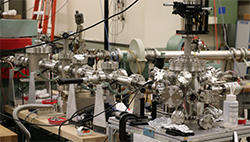
DREAM2 team member Mark Loeffler is leading a team in the Goddard Radiation Facility to get a 1 MeV Ar+ beam line in place for irradiation of minerals, simulants, and eventually lunar samples. The irradiation is anticipated to create near-surface crystal defects, which may further enhance trapping of D using a lower energy deuterium beam. A number of exciting new studies are anticipated with this two-beam experimental set-up.
New surprises found in Apollo-era data set
March 17 2017
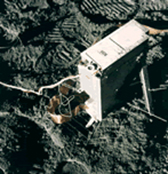
Using measurements from the Apollo 14 Suprathermal Ion Detector Experiment (SIDE), a DREAM2 team of investigators lead by Mike Collier found evidence for the formation of unusual non-monotonic surface potentials that trap photo-ions and reflect electrons. These potentials occurred when the Moon was located in the geomagnetic tail. The potentials were actually discovered a few years previously from orbiting spacecraft well-above the lunar surface. Now their signature is found in a re-examination of the rich Apollo-era surface package. Collier also enlisted the assistance of Intern Ana Newheart in searching and analyzing the exciting find – further ensuring the legacy of Apollo to the next generation of scientists.
The paper can be found at:
http://onlinelibrary.wiley.com/doi/10.1002/2016GL071457/abstract
DREAM2 Now Accepting Applications for the DREAM2Explore Workshop
March 01 2017
Grade 6-9 educators are encouraged to apply for the free DREAM2Explore Educator Professional Development Workshop, which will take place at NASA Goddard from June 26-30, 2017. For more details, and to apply, visit: http://ssed.gsfc.nasa.gov/dream/DREAM/DREAM2Explore.html
DREAM2 Submits its Program Year 3 Annual Report
February 17 2017
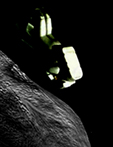
In late January, the DREAM2 team submitted its yearly report to SSERVI-Central. The report outlines the terrific work that was done in the 3rd program year – including the publication of 22 new DREAM2-funded papers, the intramural study of the space environment at Phobos, a vibrant intern program with our partners at Howard University, and highly-rated DREAM2Explore educator workshops.
The report can be downloaded at http://ssed.gsfc.nasa.gov/dream/docs/DREAM2_Annual_Report_Program_Year.012317b.pdf
New DREAM2 study finds solar storms could create discharges at the Moon’s poles
January 9 2017
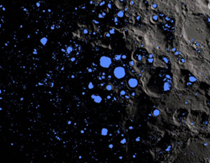
A team led by University of New Hampshire's Andrew Jordan has been examining the possibility of occurrence of deep dielectric discharge (DDD) in lunar polar regions from energetic particles associated with solar storms. They found that the cold lunar regolith at the lunar poles behaves as an insulator to allow anomalous charge build up during energetic particle events. A press release on their findings is found at
https://www.nasa.gov/feature/goddard/2017/solar-storms-charge-lunar-soil
2016 DREAM News
- NASA Official: William Farrell
- Curator: Evan McGarry
- Privacy Policy & Important Notices

